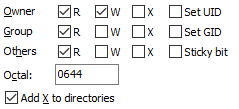Permissions
On several occasions you may need, or you may have the opportunity to set remote file permissions (Unix-style). This includes:
- Setting transfer options when
- setting default transfer options.
- setting transfer options preset.
- uploading files.
- Explicitly changing file permissions.
Advertisement
Dialogs associated with the above operations will include box (or popup box) similar to the one below.
Simple Permissions
The rows of checkboxes are used to set/unset specific permissions for the Owner (the owner of the file); the Group (members of file group); and Others (all others). The label R stands for “read permissions for file (or folder)”, W for “write” and X for “execute”. For directories the “execute permission” means permission to enter the directory (make it working directory).
Special Permissions
There are three special permissions. Set UID and Set GID are used with executable files. They grant the user, who executes the file, permissions of file owner or group, respectively. Sticky bit for executable files makes the kernel keep the memory image of the process after it has terminated, in order to avoid the overhead of reloading it when it is re-invoked. Sticky bit for directories ensures that only the owner of a file can remove or delete the file or directory.
Advertisement
Note that while non-Unix systems are usually able to map the 9 simple Unix-style permissions to their own style, they probably won’t be able to handle the 3 special permissions.
Also not all Unix SFTP servers are able to set the special permissions.
Undefined Permissions
When explicitly changing permissions of existing remote files, the checkboxes can be set to undefined state.1 It means that the particular permissions should be left to its current state. This is useful when you want to change one particular permission for set of files/directories that have different permissions.
Note that this will not work fully for SCP protocol for files in subdirectories.
Octal Format
The Octal box shows octal number representation of the permissions set by the above checkboxes. You can enter the octal format directly instead of manually ticking the checkboxes. If you enter only three numbers, the leading zero for unset special permissions is added automatically. When any of the checkboxes are in undefined state the Octal box is empty.
Note that if permissions box pops up from an edit box, you can enter permissions in octal format directly into the edit box, without having to pop it up.
Other Options
The Add X to directories checkbox makes WinSCP add “execute” permission to directories for every permission group (owner/group/others) where there is a “read” permission set already.
On the Properties dialog, the option is available only when there is at least one directory selected. Also it will not work for SCP protocol for subdirectories of the selected directories.
The checkbox is disabled, if you check “execute” permissions explicitly for all permission groups, as it makes it effectively useless.
S3 ACL
With S3 protocol, you can set basic file ACL on Properties dialog.
The rows of checkboxes are used to set/unset specific permissions for the Owner (the owner of the file); the Users (anyone with an AWS account); and Everyone (public access). The label R stands for “read permissions for the file”, R ACL for “read permissions for the file ACL” and W ACL for “write permissions for the file ACL”.
Changing permissions of S3 folders is not supported.
- Minus sign on blue background on Windows 11, small black square on Windows 10 and Windows 8; Blue square on Windows 7 and Vista; Green square on Windows XP (all for default themes).Back
Advertisement

